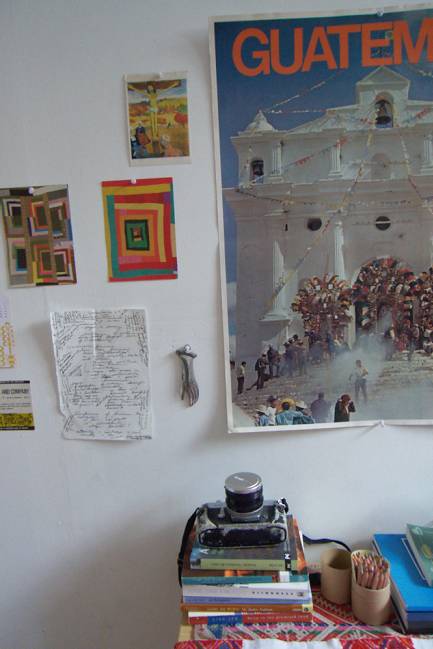At Home in Guatemala City (?)
November 28, 2009
Guatemala City is an intense place to live. A Guatemalan man told me repeatedly that it is the third most dangerous city in the world, but the number two title alternated back and forth between Baghdad and Bogota, so I’m not convinced that it’s a scientific fact. Regardless, people believe it. This city has the feel of a place at war: pedestrians look over their shoulder with alarm whenever they hear a sound behind, security guards with rifles are stationed outside fast food restaurants and elementary schools, no one goes out at night. And razor wire is everywhere.
 It’s also a city of extremes. Their is a sharp divide between the old center and the sprawling colonias, which were never fully rebuilt in the aftermath of the 1976 earthquake, and the new zones to the south, dominated by high-rise, American-style complexes that are home to the wealthy. The same extremes exist in the United States, but they are rarely so closely juxtaposed.
It’s also a city of extremes. Their is a sharp divide between the old center and the sprawling colonias, which were never fully rebuilt in the aftermath of the 1976 earthquake, and the new zones to the south, dominated by high-rise, American-style complexes that are home to the wealthy. The same extremes exist in the United States, but they are rarely so closely juxtaposed.

Notice that there is no one on the street. Outside a roughly six-block radius around the central plaza and market, this is normal.
In the midst of this madness, I feel very lucky to have landed in a beautiful neighborhood just north of the center, in a great apartment surrounded by bamboo. It’s in a compound set off the street, and when I’m inside I feel like I’m in The Secret Garden, minus the imperialist sub-plots.
The American Teacher Trials (and their Unintended Consequences)
November 23, 2009

Viola Swamp, the evil teacher in the classic picture book "Miss Nelson is Missing!"

Michelle Rhee, the face of school reform and her nemesis.......
Michelle Rhee insisted that the cover was supposed to symbolize sweeping change and assertive leadership. She was not a witch, but a hero. Who are the witches then? Bad teachers, of course: Viola Swamps that tempt little children into gingerbread schools and promptly proceed to devour their achievement potential and self-esteem. Thank goodness, then, for Superintendent Rhee, who has arrived just in time, brandishing notices of dismissal and harsh words for the child-eating-witch-enablers: teacher’s unions.
Michelle Rhee is not alone in her courageous struggle. Anyone branded as a reformer these days is likely to agree with her premier policy proposal: out with the old (bad teachers) and in with the new (preferably well-credentialed graduates of Ivy League schools.) Policy experts with less rhetorical flair and more tact emphasize the importance of “human capital,” calling for new teacher recruitment programs, the elimination of tenure and new incentive structures for high performing teachers. (Frequently, the “human capital/bad teacher” model is dished up with a large serving of free market rhetoric, a call for charter schools and a strong distaste for unions of all shapes and sizes.)
Obviously, the existence of bad teachers is not just a fairytale. I had one or two in my 10.5 years of public school, and I saw a few more in four years of teaching in Harlem. I completely agree that it’s bad when bad teachers teach students to read badly, that giving tenure to bad teachers is bad, and that a lot of bad teachers makes one very, very bad school.
But I also think it’s bad that such an obvious point- readily apparent to anyone working in any field who has noticed that when someone does something badly things do not generally end well- has come to dominate one of our most important public policy conversations. Bad teachers have become the bogeyman of education reform, polarizing the debate, obscuring the complex problems that plague the public education system, and making it more difficult for good teachers to do their job well.
Forgive my polemics. To be fair, advocates of the “human capital” approach have legitimate policy proposals and many are honestly interested in producing much needed change in public schools. But their rhetoric has had unintended consequences for teachers. I’ll talk more about policy in the future: school culture is my topic for today.
Recently, one of the teachers I worked with in college published a book. The book- It’s Not all Flowers and Sausages– was originally a blog, started as a space where she could vent her frustrations with teaching, thereby sparing her husband and saving her marriage. Contrary to what you might expect, the kids are never the problem. As recounted by “Mrs. Mimi,” they are funny, honest and kind, putting things back into perspective when the adults in the story most need it. Rather, the narrator depicts good teachers struggling to teach well in an institution that disregards their ideas and skills, fails to support their work and development, and transforms them from teachers into glorified data-collectors and readers of scripted curriculums.
With the spectre of the bad teacher looming, policymakers and administrators have lost faith in the ability of teachers to teach. In It’s Not All Flowers and Sausages, professional development “experts” insist that a phonics curriculum requiring the use of an owl puppet can be taught “in a coma” and is “guaranteed to work for every child,” staff developers assign additional assessments and grade them (incorrectly) weeks late, and legally-mandated instruction times add up to more than the average school day. There is palpable tension between teachers, resentful of their lack of control over their daily schedule, and the rest of the school staff, who ignore their concerns. Put simply, schools have become battlefields, places where even the most committed teachers face burnout and exhaustion. (I can personally attest to the widespread frustration among teachers, having been present at four years of working/venting-lunch-sessions at which many papers were graded and filed and many not-so-teacherly words were used. For the record, in my classroom at least, no eating of small children’s achievement potential occurred.)

Admittedly, we are really talking about two problems here. One is at the level of the school, where a lot of these problems could be solved with a more supportive staff, the provision of positive feedback along with constructive criticism on a regular basis, and more active inclusion of teachers in school decision-making processes. (And maybe name tags: I worked as an assistant teacher at this school for four years and neither the principal nor the vice-principal ever knew my name- a symptom, I think, of the general disregard for the work of classroom staff.)
But schools are also simply doing what they are told: implementing policy that represents the attempt of policymakers to teach for teachers. Nowhere is this phenomenon more obvious than when it comes to student evaluation and data collection. By the end of October, Mrs. Mimi has given her students “no fewer than seven tests in the area of literacy alone,” while four or five instructional days every month are set aside for math assessments. The resulting data is then graphed and submitted to the higher-ups, as well as filed in multiple portfolios and binders (my job.) Mrs. Mimi chalks all this assessment up to “testing the compliance and/or patience” of teachers, because it’s hard to believe it’s actually doing the students much good.
The “bad teacher” assumption has even filtered into progressive not-for-profits. I interned at an amazing advocacy group this summer that focused on juvenile justice and school discipline policy issues. I have great respect for their work and knowledge of the issues. But at one coalition meeting (following a few sly jokes about teachers), I realized that we were pushing for the city-wide adoption of a discipline curriculum that consisted largely of strategies already at use in the classrooms where I had worked. The only difference? Now teachers would be required to collect data, tracking improvement in students’ behavior over time. Presumably, graphs would be involved.
For all that the “human capital” approach seeks to put what happens in the classroom at the center of reform efforts, it seems to me that most of its advocates fail to understand what good teaching requires. Good teachers do not work in isolation: they thrive on collaboration and flourish in supportive institutions. Nor should teachers be isolated: if we’re serious about putting the classroom at the center, we should also engage teachers – including their unions- in the education debate. Simply getting rid of hopelessly bad teachers is only the beginning. Changes in school culture, education policy, and the tone and structure of the reform debate are necessary to make sure that good teachers stay where they are needed and that mediocre teachers improve.
Until then, the New York Collective of Radical Educators is providing what I think is an important model for teacher organizing. “Inquiry to Action” groups convene teachers to discuss classroom methodology, policy issues and social justice, providing space for critical reflection, mutual support and professional collaboration. NYCORE encourages teachers to think beyond their circumscribed role in the classroom, re-imagining their role as student advocates and political actors. You can check out their Web site here: http://www.nycore.org/. (Sorry kids, still figuring out this link business.) If schools could find a way to implement similar kinds of programming, I think it would go a long way towards addressing the combative character of school culture and would ultimately help teachers teach better.
Janitors with broomsticks aren’t capable of fixing the school system. To stretch the metaphor, we need construction crews, teams of politicians, teachers, parents and students who can renovate institutions from the inside out. But first, we need to stop imagining teachers as Viola Swamps.
México, Through the Looking Glass
November 19, 2009
Sorry for the break in posting. The lovely and amazing J was married this weekend in Oaxaca, and I was lucky enough to go. Oaxaca was elegantly colonial, the wedding was beautiful, the bride and groom were happy. It was hardly a Great Leftist Adventure, but it provided a much needed dose of gringa-ness and reminded me that there are other places in Mexico outside the Sierra Norte de Puebla.
I’ll be making up for my absence with a string of Ambitious Posts on teachers and their discontents, Freire, and a much needed (long awaited, yes?) explanation of what my project is actually all about. So check back soon!
Memoria, Verdad Y Justicia
November 12, 2009
Can you turn a pan into a pig?
November 10, 2009
Paulo Freire believed that the process of learning to read began not with letters and sounds but with whole words. These words, he wrote, should be “generative,” or somehow expressive of the students’ lived reality: clear enough to be understood enough but ambiguous enough to inspire discussion and debate. With urban workers, for example, one might use the word favela, or slum. The teacher should begin by showing a slide of the word: FAVELA. The next breaks the word into syllables (FA-VE-LA), and the next into “phonemic families” (FA-FE-FI etc., VE-VO-VI etc., LA-LO-LU etc.) The students are then invited to construct new words from the syllables, connecting their constructions with the original in complete sentences- linking the visual with the verbal, spelling and meaning.
In second grade, we had our own version of Freire’s method. Students were each given a set of letters written on individual cards, and asked to spell a series of words. Each time, the word only changed by one letter (pan to pen, pen to pin, pin to pig), but the meaning changed completely. “Can you turn a pin into a pig?” the teacher would ask. The activity was designed to practice vowel sounds, but I liked it for the same reason I like the idea of Freire’s method: it requires that students translate sound into words through the physical manipulation of visual symbols. It’s funny too.
When you are a child, you learn by listening and speaking, and only later do you begin to develop the visual vocabulary that allows you to read. But if you are like me, when you learn a language as an adult you begin first with the visual symbols, working backwards towards meaningful sound.
Why? Because I’m not thinking in Spanish. I’m thinking in English words, which I connect with known, visualized Spanish words. In turn, I have a distinct “comprehension lag”: my brain is literally transcribing the English meaning while I listen to someone speak in Spanish.
In my third week of language classes, I recognized that this was my biggest challenge. I’ve made it through 200 pages of Love in a Time of Cholera in Spanish, but when someone tells me the definition of a new word I don’t remember it five minutes later. This particular challenge also means that after carrying on what – at the time- seem like perfectly fluent conversations, I immediately begin to second guess what I understood. Or sometimes I’ll be doing really well, and my conversation partner will have just commented on how well I speak Spanish, and then they’ll ask me a question I don’t understand. After asking them to repeat it and still failing to understand, I’ll be forced to resort to nervous laughter, earnest head shaking, and an elongated “Siiiii……”
And then there is the distinct phenomenon of linguistic collapse, which happens before morning coffee or after 8 PM. These are windows of time when I avoid speaking in Spanish at all costs, as I will inevitably mix up the genders of words and forget about indirect pronouns.
It is true that after speaking Spanish almost continually for a month, I’ve improved significantly and I feel much, much more confident. It is also true that I speak the most fluently when I’ve a) written out a script before a meeting and practiced or b) visualized the interaction in my head repeatedly and intensely. Needless to say, this is exhausting.
I’ve started to wonder if I will ever speak Spanish half as well as I speak English. Last week I had lunch with a friend and his Spanish girlfriend (A and E, respectively), and he and I spent a significant amount of time moaning about our Spanish anxiety. A studied abroad in Spain, has lived in Guatemala two summers in a row, and speaks Spanish day in and day out with E (“You learn a language in the cradle or the bed,” he told me.) Yet he still admits that he can’t understand certain conversations without context.
The visual- verbal divide was most pronounced when I studied Quiché, one of the four largest indigenous language families in Guatemala. Indigenous languages have only been standardized in the last fifty years, and all use the Spanish alphabet. But Spanish letters correspond to very different sounds in Quiché, sounds that require you to make use of every part of your mouth. Take, for example, the q glottal, a cluck-like sound that is made deep in the throat. Making it repeatedly requires (for me) a very large glass of water, as your throat quickly dries out from so much slapping-of-the-epiglottis, or whatever it is. (High school biology was a long time ago.) Surprisingly, I’m pretty good at repeating these sounds when I first hear them, but I can’t seem to remember them by the end of the lesson: there is no way to write these sounds in a way that I can remember them.
My official language lessons are done, and now I’m back in Guatemala City, trying to actually figure out how I do this project I proposed a year ago. I had my first meeting with one of my contacts yesterday. I wrote out two different drafts of a script and visualized, visualized, visualized. It all went very well and beautifully fluently until she gave me her cell phone number: I had to ask her to repeat it three times. Darn numbers. How am I expected to remember Spanish 1?
All I can say is thank goodness for YouTube, and the lovely person (with way too much time on their hands) who uploaded the BBC’s new version of Emma. How do you turn a Jane Austen-lover into a Spanish speaker? Unfortunately, you cannot simply rearrange the letters.
Día de los Muertos (Por Fin)
November 3, 2009
When I was a little girl, I liked to force my family to celebrate holidays we technically weren’t supposed to observe. Hanukkah (check), Santa Lucia Day (check), Doll’s Day (Check). There might have even been a year when I went to a Kwanzaa party or two. I would like to think that this makes me some kind of multi-cultural prodigy, but it would probably be more accurate to say that I liked a) to dress up and b) eat food. (Note that neither Ramadan nor Yom Kippur are included in this list.) So when I started studying Spanish in middle school, naturally I tried to make my parents celebrate Día de los Muertos, which frankly was a little hard to do 10 years ago in Indianapolis. I remember being distinctly disappointed when we couldn’t buy sugar skulls.
Finally, I’ve seen the real thing, although alas there were no sugar skulls to be had. In Guatemala, Día de los Muertos is not as over the top as it is in Mexico, but the cemetery was still packed with people decorating graves with flowers. Everything smelled like crushed marigolds.



Graves in the "public" half of the cemetery



I was really into the flowers. Sorry.


Kites are a Día de los Muertos tradition. Anyone know if it's the same in Mexico?
























